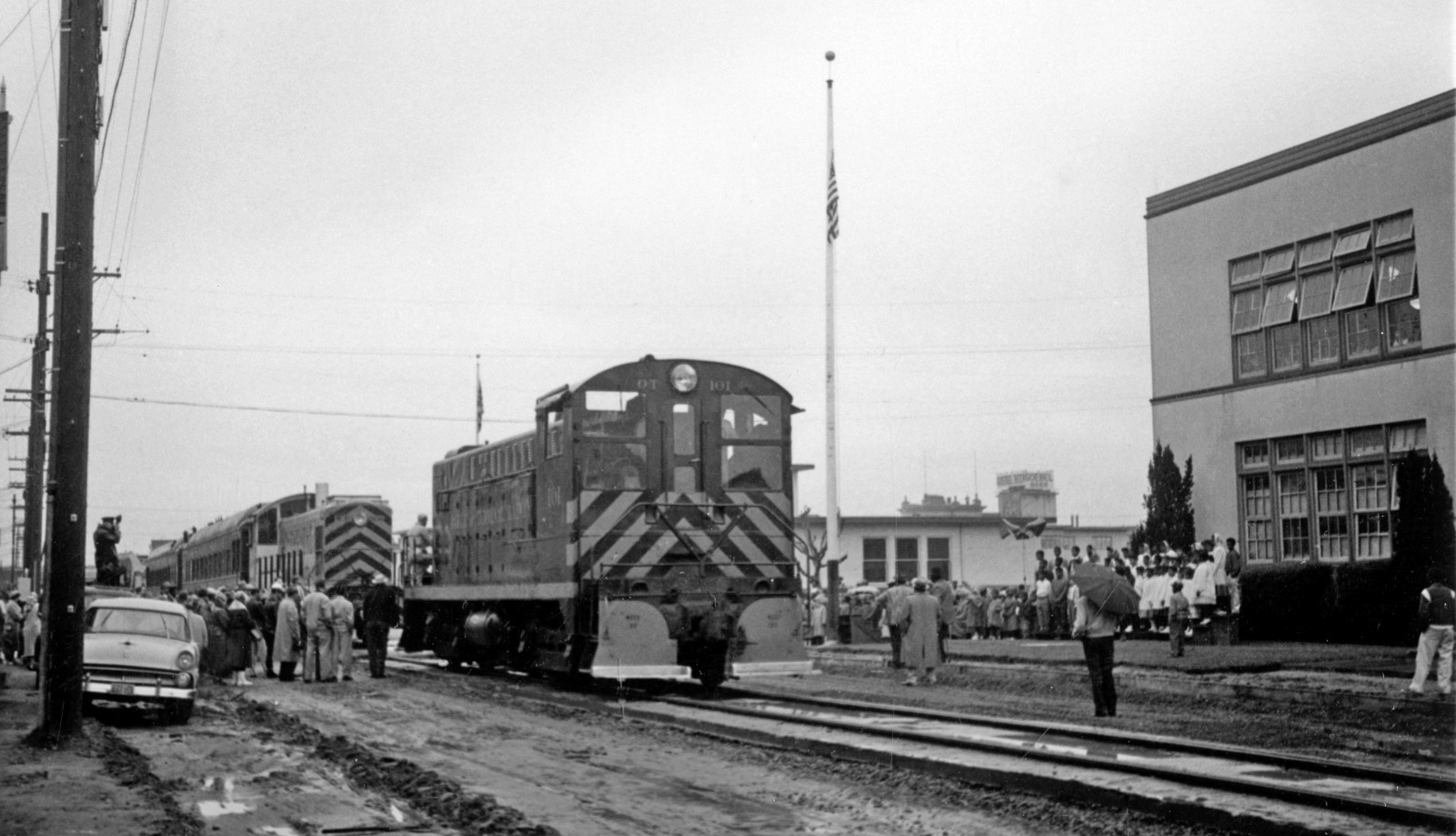The Chestnut Street Connector and War – The Western Pacific’s Lost Opportunity

A moment in time, Mar. 1, 1957. The crowd has assembled in a drizzle with Oakland Terminal Railway Baldwin DS-4-4-1000 101 and Western Pacific Alco S1 508 at 10th and Union St. at Cole Elementary School to celebrate the new Union St. connector for the Western Pacific, WP. Northeast view.
L188-05-Courtesy BAERA, Western Railway Museum Archives, 65144otry, (Image 1 of 15)

The connector meant the end of the SN west of the city of Lafayette. Here, SN 652 is shown the previous day in a southwest view at Shafter Ave., between 41st-42nd Sts., ready for the final trip to Walnut Creek and points east.
L188-10-EK Muller Photo, Courtesy BAERA, Western Railway Museum Archives, 77362sn, (Image 2 of 15)

Joining the typical freight contingent would be BAERA’s Birney car 62 and SN 653 at the rear at 41st St., northeast view, Feb, 28, 1957.
L188-15-Moreau Collection, Courtesy BAERA, Western Railway Museum Archives, 136946sn , (Image 3 of 15)

July 8, 1945, sister motors SN 604 and SN 603 enjoy a rest at Shafter Ave. and Ross St., raising dust and obstructing front-porch views in this east view. The SN would not renew its franchise on Shafter Ave. in 1946, but, as documented in the July 6, 1956 Oakland Tribune, the neighbors did not celebrate until the latter date when the Interstate Commerce Commission authorized abandonment of the rails west of Lafayette.
L188-20-Arthur Lloyd Photo, Courtesy Arthur Lloyd, (Image 4 of 15)

The decade plus delay could have been avoided had the SN’s parent, the WP, acted on a plan by San Francisco-Sacramento Railroad Co., SF-SRR, President Walter Arnstein, pictured here, who was eager to entice the WP to acquire the SF-SRR two decades earlier. Documents found together with those primarily concerning the construction of the Holland Branch and discussions with the WP beginning in Dec. 1921 follow.
L188-25-Courtesy BAERA, Western Railway Museum Archives, 136951sn , (Image 5 of 15)

As described in Sapper’s “Key System Streetcars”, page 346, the Chestnut Street line connected Moore and Scott’s shipyard along the Oakland estuary to several Key lines. It was government financed during WWI and began operation in 1918. It was reduced to shuttle service from West 8th St. in 1921, and abandoned in 1935. Considering the tens of millions of dollars the WP spent after WWI on railroad acquisitions, the twenty thousand dollar investment would have been a bargain.
L188-30-Courtesy BAERA, Western Railway Museum Archives, 40090sn, (Image 6 of 15)

The connector would have allowed trains from the Key System mainline on Yerba Buena Ave. to connect via its Poplar St. tracks to the WP. A letter from the SF-SRR to WP officials on this subject was not found, and it is entirely possible that there would have been little interest in this proposal by the latter. What follows may provide an explanation why.
L188-35-Courtesy BAERA, Western Railway Museum Archives, 40090sn, (Image 7 of 15)

Start with this 1920s George Russell north-oriented oblique aerial. Ref: API 651_7_BOX 91 thru 95
L188-40-George Russell Photo, Courtesy the California State Lands Commission , (Image 8 of 15)

In the 1920s, the WP would have seen no reason to be able to connect up to the Key System main line for lack of anything more than local freight or passenger service. Ref: API 651_7_BOX 91 thru 95
L188-41-George Russell Photo, Courtesy the California State Lands Commission, (Image 9 of 15)

A early 1920s closer look where Chestnut St. met both WP and Southern Pacific, SP, main lines. Ref: WRM, Central National Bank of California Map 1921 83537a; CSLC, API 651_7_BOX 91 thru 95
L188-45-Courtesy BAERA, WRM Archives and the California State Lands Commission, (Image 10 of 15)

The connector was never built as shown in this southeast view from Apr. 24, 1954 of Chestnut St., red arrow at 5th St., toward the WP main line at 3rd St., green arrow.
L188-50-Copyright California Department of Transportation, 3800-3 , (Image 11 of 15)

In 1939, the area between the Bay Bridge and SP Alameda mole looked pretty much as it did when the Chestnut Street option was discussed. Now owning the SN, the WP would not have foreseen the changes that were to take place in the area in the 1940s.
L188-55-USDA Western Division Photo, But-290-3, Courtesy El Cerrito Historical Society, (Image 12 of 15)

World War II changed all of the previous assumptions of the growth potential in West Oakland with the formation of the Oakland Army Base in 1941. Unlike the SP, the WP had no direct option to supply the new base, but the SN had rights over the Key System tracks. Ref: ALA-C-19L-24, 2/4/36, left; ALA-C-19L-57, 2/2/55, right.
L188-60-Pacific Resources Inc. Photos, Courtesy Oakland History Room, Oakland Public Library, (Image 13 of 15)

Fortunately for the WP, the Key System freight operation, the Oakland Terminal Railroad, had been struggling during the war. Shown here, switcher 1000 is shown in an east view pulling freight onto 40th Street. The WP and Santa Fe bought the line in mid-1943 and renamed it the Oakland Terminal Railway, OTR. Now only 9 blocks separated the OTR line at 12th St. and the WP mainline at 3rd St. and direct access to the Oakland Army Base.
L188-65-Courtesy BAERA, Western Railway Museum Archives, 56804ks, (Image 14 of 15)

SN 440, assigned to the OTR as were other SN 600-volt freight motors, leads a freight with its light shield in place for wartime operation on Dec. 4, 1943; the 1943 license plate was unique. As for the SN, freight revenue was sufficient with practically no investment to upgrade the operation as the war ended. Next time, the SN and the war on Shafter Ave.
L188-70-Arthur Lloyd Photo, Courtesy Arthur Lloyd, (Image 15 of 15)